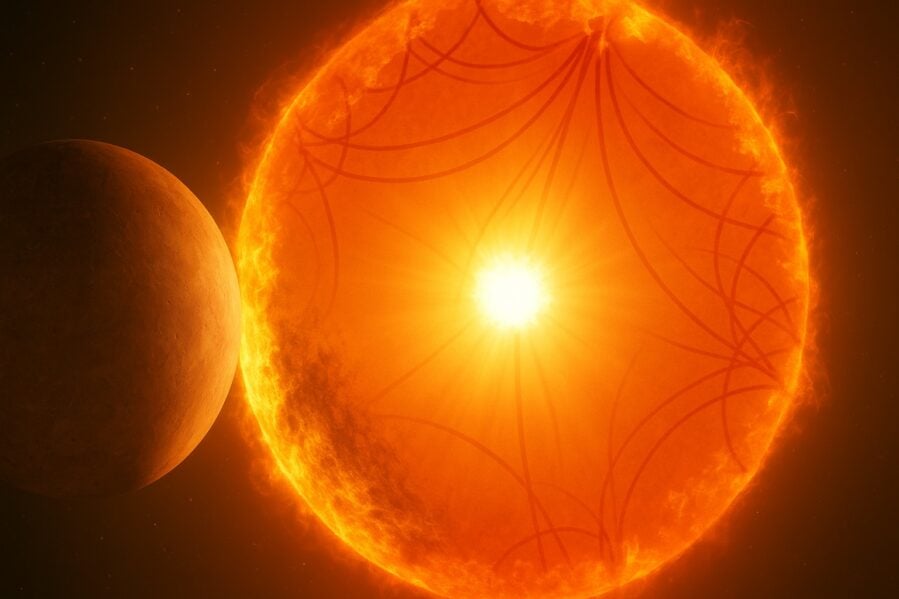A nearby star’s subtle vibrations, detected by astronomers using cutting-edge instruments on Hawaii’s Maunakea, have uncovered surprising features that challenge our understanding of stellar physics and aging processes. These findings may transform how we determine the ages of stars and their accompanying planets.
Listening to a Star’s Secret Song
Like musical instruments, stars vibrate with unique patterns that can reveal their innermost structure. Using the Keck Planet Finder (KPF), astronomers have for the first time captured these subtle oscillations in a cool orange star just 21 light-years from Earth.
“The vibrations of a star are like its unique song,” said Yaguang Li, lead author and researcher at the University of Hawaii at Mānoa. “By listening to those oscillations, we can precisely determine how massive a star is, how large it is, and how old it is.”
What makes this discovery significant is that these subtle movements—with the star’s surface moving at speeds less than 5 centimeters per second—are nearly impossible to detect with conventional instruments. Over four consecutive nights, researchers collected more than 2,000 ultra-precise measurements to capture the star’s vibrations.
A Star Twice as Old as Our Sun
The team determined that HD 219134, the orange star at the center of this study, is approximately 10.2 billion years old—more than twice the age of our Sun. This makes it one of the oldest “main sequence” stars ever measured using this technique.
This ancient status provides astronomers with a rare calibration point for stellar dating methods. Stars gradually slow their rotation as they age, much like spinning tops winding down. However, something curious happens with stars like HD 219134: their slowing rotation appears to stall at certain points in their lifetime.
Finding such an ancient star with precisely measured properties helps astronomers refine their understanding of how stars age over billions of years.
Key Discoveries That Challenge Stellar Models
- HD 219134 appears to be smaller than expected based on other measurement techniques
- The star’s vibration patterns differ from those of Sun-like stars, suggesting fundamental differences in stellar structure
- The star’s age of 10.2 billion years makes it one of the oldest directly measured stars still in its main sequence phase
- The star hosts at least five planets, including two rocky super-Earths with likely Earth-like compositions
A Cosmic Mystery: Why Is This Star Smaller Than Expected?
Perhaps the most puzzling discovery is that HD 219134 appears approximately 4% smaller than measurements taken using interferometry, another highly precise astronomical technique. This significant discrepancy suggests either unrecognized issues with our measurement techniques or gaps in our understanding of stellar physics—particularly for cooler stars.
“This is like finding a long-lost tuning fork for stellar clocks,” said Li. “It gives us a reference point to calibrate how stars spin down over billions of years.”
Are our stellar models incomplete? Do magnetic fields play an unexpected role in star structure? Or could there be systematic measurement errors we haven’t accounted for? The research team investigated several possibilities but couldn’t fully explain the discrepancy.
What This Means for Exoplanet Research
The findings have important implications for planets orbiting distant stars. HD 219134 hosts at least five planets, including two rocky super-Earths that transit across the star’s face. With improved measurements of the star’s size, astronomers could refine these planets’ properties, confirming they likely have solid, rocky surfaces similar to Earth.
This approach will become increasingly important as astronomers search for potentially habitable worlds in the coming decades.
“When we find life on another planet, we will want to know how old that life is,” said Dr. Daniel Huber, a co-author on the study. “Listening to the sounds of its star will tell us the answer.”
The findings appear in the May 6, 2025 issue of The Astrophysical Journal, opening new possibilities for understanding the universe’s oldest stars and their accompanying planets.
If our reporting has informed or inspired you, please consider making a donation. Every contribution, no matter the size, empowers us to continue delivering accurate, engaging, and trustworthy science and medical news. Independent journalism requires time, effort, and resources—your support ensures we can keep uncovering the stories that matter most to you.
Join us in making knowledge accessible and impactful. Thank you for standing with us!

